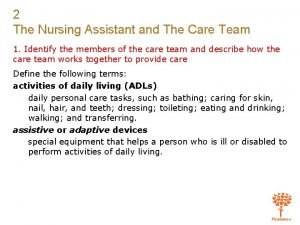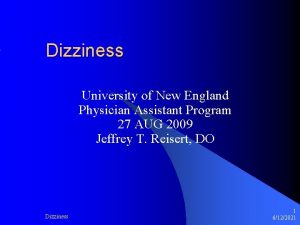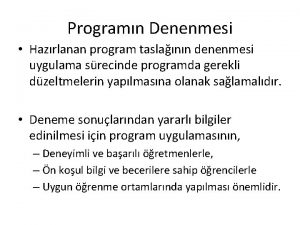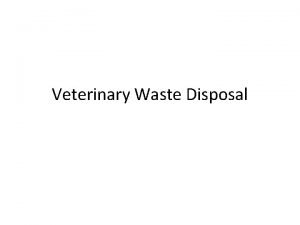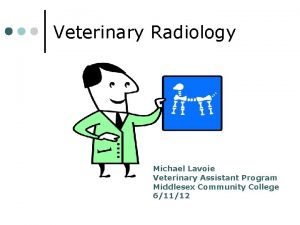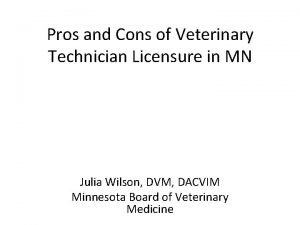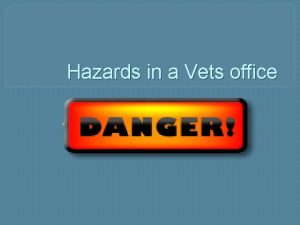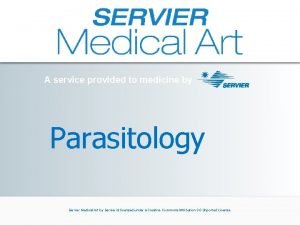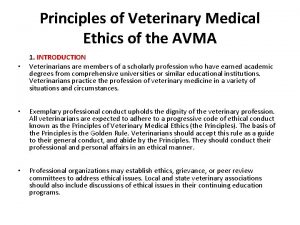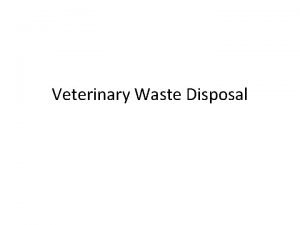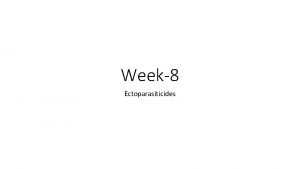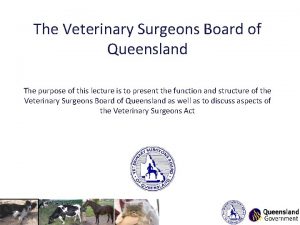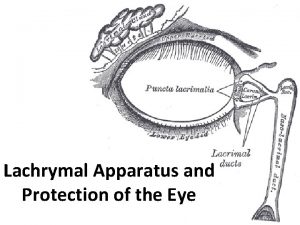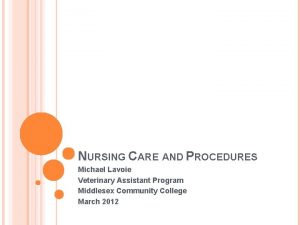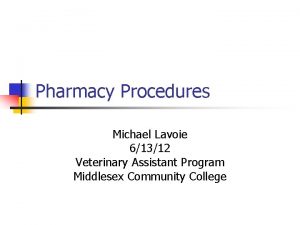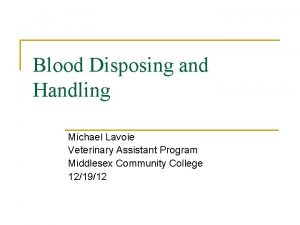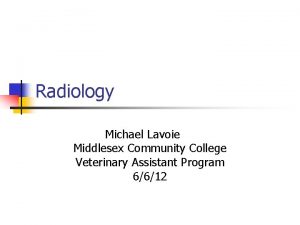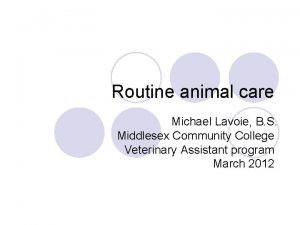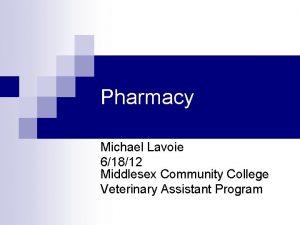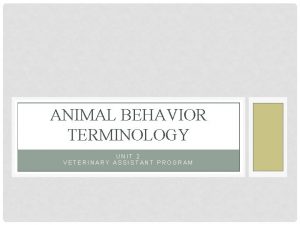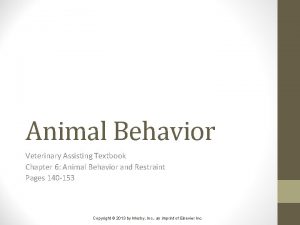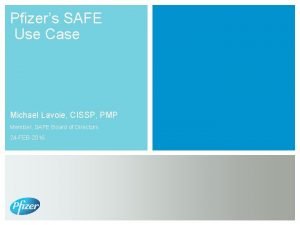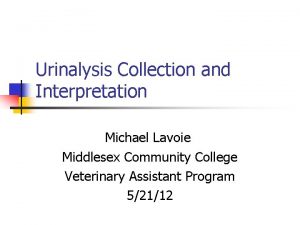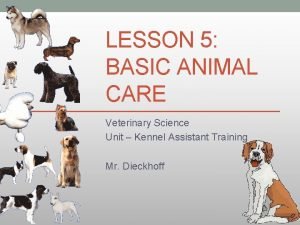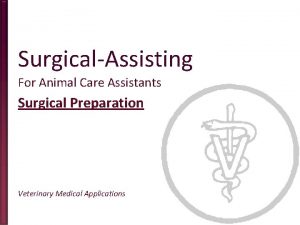Small Animal Care Michael Lavoie Veterinary Assistant Program































































- Slides: 63

Small Animal Care Michael Lavoie Veterinary Assistant Program Middlesex Community College September 2011

Ear Cleaning- Dogs l Ear cleaning and medicating can be messy so cover good clothes and work on a surface that is easy to clean. l Most dogs do not like having their ears cleaned. l Some dogs will happily sit in your lap or on a table while you clean or medicate their ears but many require some form of restraint.

Restraint l l l One method to restrain the dog is to place her/him on a table. Stand on the side of the table opposite to the ear you are medicating; in the photograph the right ear is being medicated. Drape your right arm over the dog's shoulders. Wrap your left arm around the head and neck and use the finger tips of the left hand to push the ear flap back and up to expose the inner surface of the ear. If the dog tries to stand you can lean your body over them to keep them from rising.

l l l If your dog is too wiggly, try laying him/her on his/her side. Reach over his/her neck with your left arm and firmly grasp the elbow of the leg closest to the table. Always hold the leg close to the elbow, NOT close to the toes. Keep your left elbow on his/her neck to prevent him/her from picking up his/her head. Use the fingers of your right hand to pull back the ear flap to expose the inner side of the ear.

The ear has 3 major parts: outer ear l middle ear l inner ear l

The Outer Ear l The outer ear consists of the ear flap (also called the pinna) which can be upright (a prick ear) or floppy. l The ear flap funnels sound into the ear canal. l Unlike humans that have a very short ear canal, dogs have a long narrow ear canal that makes almost a 90 degree bend as it travels to the deeper parts of the ear.

The middle ear The outer ear cannel is separated from the middle ear by a thin membrane called the eardrum or tympanic membrane. l The ear drum is very fragile and can be damaged by ear disease or during ear cleaning. l The middle ear consists of 3 small bones, an air filled cavity called the bulla and a thin tube (the eustachian tube) leading from the bulla to the back of the mouth. l

The inner ear l The inner ear connects to the brain and contains nerves and centers for balance and hearing.

Ear Infections- cats vs. dogs Dogs have many more ear problems than cats. l Dogs with heavy floppy ears have the most problems with ear infections. l Some breeds have lots of hair in and around the ear canal which causes them to develop ear infections. l Dogs that spend lots of time in the water also are prone to developing ear infections. l

Additional anatomy l l l The outer ear flap is usually covered with fur. If the ear is itchy, scratching may result in hair loss on the ear flap or at the base of the ear. Severe scratching may also lead to tears at the edges of the ear. Ear damage may lead to bleeding between the skin and cartilage of the ear flap; a hematoma. The ear flap is swollen, red and painful

l l l l The inner side of the ear should be a healthy pink color. A small amount of black discharge may be observed. Ear infections may result in: redness discharge odor head shaking ear scratching rubbing ears on the floor or other surfaces

Ear cleaning can be accomplished with the following supplies ear wash solution l cotton balls l a tweezers or hemostat to pluck hair l q tips may be used if used properly l

l l l Other things to look out for when ear cleaning: If the "non-furred", inner side of the ear flap contains lots of fur at the opening to the ear canal, a few hairs at a time can be plucked. Lots of hair at the opening to the ear canal reduces air flow into the ear. Good air flow is important to maintaining a healthy ear. Some dogs that have this issue are poodles, bichons, schnauzers, etc.

Cleaning The ear wash solution is squeezed into the ear canal. l A few drops of ear wash should be applied to the inside of the ear flap and then the tip of the ear wash bottle should be inserted a few millimeters into the ear canal, to place some of the wash solution down the ear canal. l Be careful not to tightly force the tip of the bottle into the ear canal as forceful squeezing of the bottle with the bottle wedged into the ear canal could rupture the ear drum. l The dog will usually shake its head as soon as the wash is inserted into the ear, shaking out much of the solution. l

Massage the base of the ear to distribute the wash solution throughout the ear canal. l Dogs usually like this part. l You do this by massaging at the base of the ear as shown in the picture. l

Use cotton balls to remove discharge from the inner side of the ear flap. You can also use q tips to clean the inner side of the ear flap l BUT. . . l DON'T stick q tips into the ear any further than you can see. l Deep placement of a q tip can rupture the ear drum or can pack wax and other debris further into the ear canal, preventing medications from getting to the deeper parts of the ear canal. l

Ear medications may contain several different drugs and may be ointments (pictured on the left and in insert) or drops (pictured on the right). l Ear medications are most effective when placed in a clear ear. l If they are placed on top of ear wax or other debris they will not be as effective. l Your veterinarian will give you instructions, if cleaning is needed before ear medications are given. l

l Sometimes your veterinarian will recommend a thorough ear exam under sedation or anesthesia if: l the dog will not allow cleaning awake l it is suspected that a foreign body such as plant material is inside the ear canal l the veterinarian needs to collect samples from the ear for cytology or culture

l l l Dogs with chronic ear infections will benefit from anything that increases air flow into the ear canal. Ear flow can be improved by: plucking hairs from around the opening of the ear canal tying or taping ears together on top of the head If the infection is severe or involves the middle and inner ear, oral medications may also be prescribed. Surgery is sometimes necessary if the infection is in the middle ear.

Ear Cleaning- Cats l Ear cleaning and medicating can be messy, so cover good clothes and work on a surface that is easy to clean. l Most cats do not like having their ears cleaned.

Restraint To hold your cat in your lap to place ear medications, drape your left forearm across the cat's body to keep him/her in your lap. l Hold the head with your left hand using your left thumb to press the ear flap against the head with the ear canal open. l Hold the medication in your right hand or left hand dependent on which ear you are cleaning l

The ear has three parts outer ear l middle ear l inner ear l

Other anatomy The outer ear flap is usually covered with fur. l If the ear is itchy, scratching may result in hair loss on the ear flap or at the base of the ear. l Severe scratching may also lead to tears at the edges of the ear. l

l l l l l The inner side of the ear should be a healthy pink color. A small amount of black discharge may be observed in some cats. A large amount of black wax is often seen in cats with ear mites. Ear infections may result in: redness discharge odor head shaking ear scratching rubbing ears on the floor or other surfaces

l l l l Ear cleaning can be accomplished with the following supplies: ear wash solution cotton balls a tweezers or hemostat to pluck hair q tips may be used if used properly Ear cleaning solutions contain various chemicals and may contain drying agents. Check with your veterinarian regarding which product to use and how often to use it. Excessive ear cleaning can be damaging to the ear.

The ear wash solution is squeezed into the ear canal. l A few drops of ear wash should be applied to the inside of the ear flap, then the tip of the ear wash bottle should be inserted a few millimeters into the ear canal, marked by the yellow X to place some of the wash solution down the ear canal. l Be careful not to tightly force the tip of the bottle into the ear canal as forceful squeezing of the bottle with the bottle wedged into the ear canal could rupture the ear drum. l The cat will usually shake its head as soon as the wash is inserted into the ear, shaking out much of the solution. l

Massage the base of the ear to distribute the wash solution throughout the ear canal. l Cats usually like this part. l You do this by massaging at the base of the ear as shown in the picture l

Use cotton balls to remove discharge from the inner side of the ear flap. You can also use q tips to clean the inner side of the ear flap l BUT. . . l DON'T stick q tips into the ear any further than you can see. l Deep placement of a q tip can rupture the ear drum or can pack wax and other debris further into the ear canal, preventing medications from getting to the deeper parts of the ear canal. l

Ear medications may contain several different drugs and may be ointments (pictured on the left and in insert) or drops (pictured on the right). l Ear medications are most effective when placed in a clear ear. l If they are placed on top of ear wax or other debris they will not be as effective. l Your veterinarian will give you instructions, if cleaning is needed before ear medications are given. l

l Sometimes your veterinarian will recommend a thorough ear exam under sedation or anesthesia if: l the cat will not allow cleaning awake l it is suspected that a foreign body such as plant material is inside the ear canal l the veterinarian needs to collect samples from the ear for cytology or culture

Pilling a dog l For medicines that can be taken with food, offer your dog a bit of soft cheese, such as American cheese, to see if he likes the flavor. l If he gobbles up the cheese, try it again, but this time put the pill inside the cheese. l Most dogs will swallow it whole and your problem is solved. l If that doesn’t work, move to step 2.

l Offer your dog a bit of peanut butter. l Most dogs love the flavor l spoon out about a tablespoon of peanut butter and bury the pill inside the mound of peanut butter. l Put the "treat" on your finger and offer it to your dog. l If this doesn’t work, go to step 3.

l Make a "meatball" out of some favorite canned dog food. l Squash the meat around the pill (if it is OK to take with food) and see if the dog will swallow it all. l If he refuses, or spits out the pill, try making a game out of it and toss him the treat. l If this doesn’t work, go to step four

l l l Hold the dog's upper jaw with your left thumb and index finger (if you are right-handed), tilting the head back and folding the gums over the upper teeth. With the right hand, hold the pill between the thumb and index finger. With the right middle finger, press down on the lower incisors (front teeth) to open the mouth. At the same time put your left thumb on the roof of the mouth. By gently pressing up on the roof of the mouth and down on the lower incisors, you will hold the mouth open

Drop the pill as far back on the tongue as possible, then quickly close the dog's mouth and rub its throat in a downward motion. l This stimulates its swallowing reflex. l Blowing on a dog's nose can also cause it to swallow. l Offering your pet a drink of water afterwards is a good idea to help wash the pill down its throat. l

Tips for pilling a dog ¡ Talk calmly and quietly while you are pilling ¡ Praise after the pill is given ¡ Make it a pleasant event, never let it become a battle to give medicine ¡ Relax when pilling your dog, they can sense anxiety

Pilling a cat Grab the cat from behind the face, making sure that your thumb and index are positioned on the maxillary joint. l It is good if you can do this with the cat sitting on a high place, so you do not need to bend over. l

Slowly, shift the cat’s head backwards, gently raising her mouth. l She does not like it, but she does not object, either. l Apply a slight pressure on her jaws, with your thumb and index (or middle finger). l The mouth will still be closed. l

Gently sneak your middle or ring finger between her front teeth, and push down the bottom jaw. l The cat has no power in it when her head is bent backwards, so she won’t bite back. l Before attempting this, take the pill and hold it with your thumb and your index finger l

Now, as the cat’s mouth is wide open, throw the pill as fast and as deep as you can inside. l Try to aim the bottom of the throat, in order to avoid the contact of the pill with the tongue. l Thus, the cat cannot detect the unpleasant taste, so she won’t spit the pill (yet!). l Keep her mouth closed and gently rub her neck, until you feel that she swallowed. l

Release the cat and watch her closely for about 10 seconds: if she licks her mouth, it means that she swallowed the pill. l Nevertheless, look around her, because some cats are tricky: they pretend they swallowed, and when you don’t watch, they spit the pill which was all the time in their mouth l Give her a nice treat, so she gets used that this is part of the ritual. l

Trimming cats nails Notice the pink tissue (the quick) on the inside of the claw. l Avoid the quick when you trim the claw; cutting into it will cause pain and bleeding l Remove the sharp tip below the quick (away from the toe), clipping about halfway between the end of the quick and the tip of claw. l

l To restrain a cat in your lap, use your forearms draped over the cat's neck and hind-end to keep the cat in your lap. The clipper is held in the right hand.

There are several styles of nail trimmers, including a guillotine type, a scissors cut, and a standard human fingernail clipper. l Either the guillotine type or a human fingernail clipper are easiest to use in cats. l The scissors-type is used if a toe nail is so long that it is curling in a circle. Long claws can grow into the toe pad. l

l Close you hand around the clipper to squeeze the handle which will move the cutting blade.


l Cats have retractile claws so you need to gently squeeze the toe between thumb and forefinger to expose the claw.

l The clipper should be placed perpendicular to the nail (cutting top to bottom).

l Light colored claws can be trimmed with one cut on each nail.

l If the trimmer is placed parallel to the nail (cutting from side to side), the nail is crushed and may splinter.

l The sharper the trimmer, the cleaner the cut. You can use a nail file to smooth the end of the nail after clipping

l l l When using a guillotine type nail trimmer, the cutting blade (outlined in yellow) should be facing you, not the cat. The screws on the trimmer should be facing the cat. The nail should be cut from top to bottom, not side to side. The tip of the nail is placed in the hole in the trimmer and the handles are squeezed to advance the cutting blade through the nail. The handles of the trimmer can be held pointing toward the floor or ceiling, whichever is most comfortable for you.

Cats have a nail on the inner side of each foot called the dew claw. l Remember to trim these as they are not worn down when the cat scratches and can grow in a circle, growing into the foot. l

Trimming a dog’s nails l l l One method to restrain the dog is to place her/him on a table. Stand on the side of the table opposite to the claws you are trimming. Drape your arms and upper body over the dog. When trimming the front claws, keep your left forearm over the neck to keep the dog from lifting its head. Hold the paw in your left hand hold the trimmer in your right hand. If the dog tries to stand, lean your upper body over his/her shoulders to prevent him/her from rising.

If your dog is too wiggly, try laying him/her on his/her side. l Use your right arm and upper body to keep the dog laying on his/her side. Hold the trimmer in your right hand. l Use your left arm to keep the head on the table and use the left hand to hold the paw. l It is easier to perform this procedure with a helper l

There are several styles of nail trimmers, including a guillotine type and a scissors type. l The guillotine type is the easiest to use in dogs. l

l l l The scissors-type is used to trim a toenail that is so long that it is curling in a circle. Long claws can grow into the toe-pad. This most often happens to dew claws, the claw on the inner side of the paw. Dew claws do not touch the ground so they are not worn down as the dog walks. The dew claw is attached to the leg by loose skin. The dew claw can usually be bent away from the leg so that you can fit a guillotine type trimmer over the tip of the dew claw.

l l l Unlike cats, dogs do not have retractile claws. The color of the nail is determined by the color of the surrounding skin and hair. This dog has black claws on the brown paw and a mixture of white and black claws on the white paw. Always remember to trim the dew claws that are located on the inner surface of the paw.

l Light colored claws are easier to cut than dark claws as the blood vessels and nerves that supply the toenail, called the quick, is easier to see.

l You cannot see the quick on dark colored claws, making them more difficult to trim without cutting into the quick.

l Cut dark colored claws in several small cuts to reduce the chance of cutting into the quick

If the toenail is cut too short, you can use a styptic pencil containing silver nitrate to stop blood flow, although many animals object to the styptic pencil as much, or more, than toenail cutting. l The black end of the stick is held to the bleeding nail and gently rotated until bleeding stops. l Even without any treatment the nail should stop bleeding in about 5 minutes or less. l

Questions
 Lewis lavoie
Lewis lavoie Jde lavoie
Jde lavoie Tammie lavoie
Tammie lavoie Levels of health care primary secondary tertiary
Levels of health care primary secondary tertiary Kpu health care assistant
Kpu health care assistant Palliative care assistant
Palliative care assistant The nursing assistant and the care team
The nursing assistant and the care team Describe the care team and the chain of command
Describe the care team and the chain of command Medical assistant rop
Medical assistant rop University of new england physician assistant program
University of new england physician assistant program One to one communication in health and social care
One to one communication in health and social care Plant vs animal mitosis
Plant vs animal mitosis Animal cells and plant cells venn diagram
Animal cells and plant cells venn diagram Similarities between animal rights and animal welfare
Similarities between animal rights and animal welfare Metfessel-michael değerlendirme modeli
Metfessel-michael değerlendirme modeli Provus'un farklar yaklaşımı ile değerlendirme modeli
Provus'un farklar yaklaşımı ile değerlendirme modeli Columbus animal care and control
Columbus animal care and control Irvine animal care center
Irvine animal care center Veterinary waste disposal legislation
Veterinary waste disposal legislation Flattened diaphragm
Flattened diaphragm Father of veterinary parasitology
Father of veterinary parasitology Veterinary medicines directorate
Veterinary medicines directorate Bcse sample questions
Bcse sample questions Veterinary nurse conduct and discipline rules 2014
Veterinary nurse conduct and discipline rules 2014 Vet tech pros and cons
Vet tech pros and cons Brig ajit meelu
Brig ajit meelu Myerscough veterinary nursing
Myerscough veterinary nursing Veterinary services division
Veterinary services division Lincoln memorial university college of veterinary medicine
Lincoln memorial university college of veterinary medicine Physical hazards in a veterinary clinic
Physical hazards in a veterinary clinic Vet tech jeopardy
Vet tech jeopardy Veterinary radiology dallas county
Veterinary radiology dallas county Controlled substance log example
Controlled substance log example Bihar veterinary college
Bihar veterinary college Servier medical art
Servier medical art Word drill suffixes 1
Word drill suffixes 1 Veterinary university brno
Veterinary university brno Minnesota diagnostic lab
Minnesota diagnostic lab Avma code of ethics
Avma code of ethics Penulisan resep injeksi ranitidin
Penulisan resep injeksi ranitidin Exclusively equine veterinary services
Exclusively equine veterinary services National veterinary services laboratory
National veterinary services laboratory Faculty of veterinary medicine cairo university logo
Faculty of veterinary medicine cairo university logo Disposing of veterinary clinical waste
Disposing of veterinary clinical waste Legal consent forms for veterinary practices
Legal consent forms for veterinary practices Paten brno
Paten brno Veterinary medicinal product dossier
Veterinary medicinal product dossier Common veterinary medical equipment vocabulary
Common veterinary medical equipment vocabulary Great plains veterinary educational center
Great plains veterinary educational center Veterinary medical abbreviations
Veterinary medical abbreviations Ectoparasiticides veterinary medicines
Ectoparasiticides veterinary medicines Center for veterinary biologics
Center for veterinary biologics Auricle of heart vs atrium
Auricle of heart vs atrium Vet surgeons board qld
Vet surgeons board qld Veterinary hippocratic oath
Veterinary hippocratic oath Veterinary biologics market
Veterinary biologics market Vm 544
Vm 544 Polchem hygiene laboratories
Polchem hygiene laboratories Veterinary ophthalmology
Veterinary ophthalmology Pharmacology for veterinary technicians
Pharmacology for veterinary technicians Autoclave tape indicator veterinary
Autoclave tape indicator veterinary Ethics in veterinary medicine
Ethics in veterinary medicine Malaysia veterinary council
Malaysia veterinary council Veterinary terminology prefixes and suffixes
Veterinary terminology prefixes and suffixes






